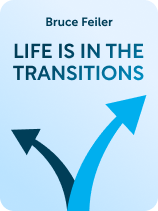

This article is an excerpt from the Shortform book guide to "Life Is in the Transitions" by Bruce Feiler. Shortform has the world's best summaries and analyses of books you should be reading.
Like this article? Sign up for a free trial here.
Do you struggle to cope with emotions? How can you overcome the emotions that arise with grief?
Bruce Feiler’s book Life Is in the Transitions deals with overcoming major life changes called “lifequakes.” When changes happen, it’s normal to grieve the life you used to have. However, learning how to handle those emotions is an important part of moving forward.
Here’s Feiler’s advice for learning to cope with fear, sadness, and shame.
Cope With Your Emotions
Feiler’s strategy involves understanding and finding out how to cope with emotions that come up while you’re grieving the end of your old reality—particularly fear, sadness, and shame.
How to Cope With Fear
During his research, Feiler observed that many people had to overcome fear as they transitioned from a major life change. He names a few common strategies that can help with this. The first is to compare the discomfort you feel in your current reality to the fear of making a big life change. Transitions can be scary, but staying stuck in the same old rut forever may be even more terrifying.
(Shortform note: According to Ryan Holiday, developing courage—the willingness to do the right thing even though you’re scared—can help you deal with the fear that accompanies major life changes. In Courage Is Calling, he argues that usually, the right choice is the scariest or most difficult one, and you should embrace opportunities to disrupt your status quo.)
Another strategy Feiler recommends is to make a list of your goals, which can motivate you to overcome your fears. (Shortform note: In The Pathless Path, Paul Millerd recommends dealing with fear by making another type of list. He says you should write down the worst possible scenario that could result from a life change, steps you could take to recover from this, potential benefits associated with the life change, and what you’d miss out on if you didn’t go for it. This can make your fears more manageable by instilling confidence that you can handle setbacks and by shifting your focus from risks to rewards—which can be another way of focusing on goals.)
Finally, Feiler says you can choose to face your fears head on—for example, if you’re afraid of going back to school, you might decide to swallow that fear and sign up for classes anyway. (Shortform note: In Letting Go, David Hawkins offers two strategies you can use to face your fears head on. First, he recommends acknowledging that you don’t need to be afraid of fear and coming to terms with how your fears are holding you back. Second, he says you can reframe your decisions in terms of love instead of fear—for example, if you’re thinking about going back to school, focus on your love for learning or the positive impact it could have on your life and the lives of others, rather than on your fear of failure or inadequacy.)
How to Cope With Sadness
Another common emotion people face during life changes is sadness. Feiler notes three strategies people use to cope with sadness. The first is accepting the sadness—allowing it to be part of your story without trying to get rid of it. The second is leaning on loved ones for support while you grieve. The third is facing the source of your sadness by talking about it or deliberately reminding yourself of it, allowing you to fully feel your grief.
(Shortform note: Some believe that sadness is a valuable part of life. For example, in Life Worth Living, the authors explain that Oscar Wilde believed his life was enriched by the suffering he experienced when he was imprisoned for sodomy. According to Wilde, being unhappy deepens your understanding of what life’s all about. Adopting this perspective could help you with any of the three strategies Feiler recommends—it could help you accept your grief on its face, enhance your appreciation of the support your loved ones provide, or give you the motivation you need to fully feel your grief.)
How to Cope With Shame
Finally, many people feel shame during transitions as they look back on the perceived failures of their lives. In interviews, Feiler gathered that the best way to combat this shame is to invest time and effort into the aspects of your life that the shame impacts the most. You can do this by taking actions that directly address the areas where you feel you’ve fallen short. For example, if you feel shame about hurting your family and thus feel separated from them, the best way to counteract that shame would be to attend a family event and reconnect with them—to restore your sense of belonging.
(Shortform note: In Being Wrong, Kathryn Schulz explains that failures and mistakes can deeply affect your sense of self. Schulz argues that embracing and learning from your mistakes is crucial for personal growth. Applying this to Feiler’s observation, confronting the shame tied to your perceived failures can help you reframe these experiences as opportunities for growth. By focusing on the source of meaning that the shame impacts the most, you can rebuild your sense of self and restore your connection to the parts of life you find most meaningful.)

———End of Preview———
Like what you just read? Read the rest of the world's best book summary and analysis of Bruce Feiler's "Life Is in the Transitions" at Shortform.
Here's what you'll find in our full Life Is in the Transitions summary:
- How to deal with curveballs and obstacles in life
- The pattern that most of life’s disruptions follow
- How to rewrite your life story in a positive way






